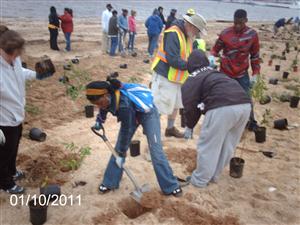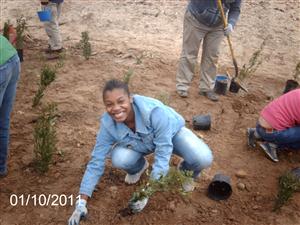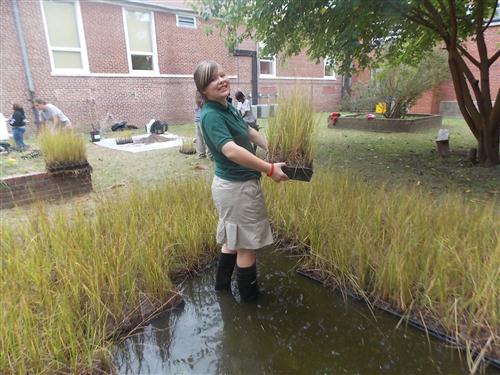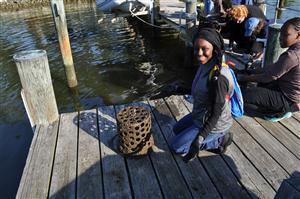 Students at Baltimore’s Ben Franklin High School are using their involvement with PLT GreenSchools and their proximity to Baltimore Harbor to tackle one environmental challenge after another, determined to make a difference in greening their school and community.
Students at Baltimore’s Ben Franklin High School are using their involvement with PLT GreenSchools and their proximity to Baltimore Harbor to tackle one environmental challenge after another, determined to make a difference in greening their school and community.
“Our school is located in the most polluted area of Baltimore, and one of the most polluted places in the state of Maryland,” said Albina Joy, the lead teacher in Ben Franklin’s science department. “Thinking about ways to solve our city’s environmental problems has been a major focus of our GreenSchools work.”
Students Present Their Recommendations
 Using the PLT GreenSchools Environmental Quality Investigation, “the kids have studied pollution, met with and made recommendations to the school board, and developed a major presentation, which they gave several times to various community groups, on the need for clean, green spaces to serve our community,” said Joy. Ben Franklin’s Green Team also presented with the national PLT office at a regional National Science Teachers Association conference.
Using the PLT GreenSchools Environmental Quality Investigation, “the kids have studied pollution, met with and made recommendations to the school board, and developed a major presentation, which they gave several times to various community groups, on the need for clean, green spaces to serve our community,” said Joy. Ben Franklin’s Green Team also presented with the national PLT office at a regional National Science Teachers Association conference.
With the school located just across from Masonville Cove on the Chesapeake Bay, the issues affecting the Bay’s ecosystem have been a major emphasis for Ben Franklin’s Green Team. So have community gardens—an appropriate subject for a school with a curriculum organized around service learning, environmental science, and urban agriculture.
Taking Action to Save the Bay
 PLT GreenSchools encourages schools to develop community partnerships. As part of a partnership with the Baltimore Aquarium, Ben Franklin students raise bay grass in specially constructed wetland containers on the school’s grounds. When the plants mature, students transplant them to floating wetlands in Masonville Cove, where the grasses help filter the water and support marine wildlife.
PLT GreenSchools encourages schools to develop community partnerships. As part of a partnership with the Baltimore Aquarium, Ben Franklin students raise bay grass in specially constructed wetland containers on the school’s grounds. When the plants mature, students transplant them to floating wetlands in Masonville Cove, where the grasses help filter the water and support marine wildlife.
Working with the Shores of Baltimore Land Trust and the Baltimore Aquarium, Green Team students have played an ongoing role in helping to transform Masonville Cove from a site known for illegal industrial dumping to a model environmental education center and bird sanctuary on 54 acres of reclaimed wetlands.
To anchor soil dredged from Baltimore Harbor so that it will not wash back into the bay, Green Team students planted 3,000 trees and bushes on the site. They also constructed a native wetland pond with a waterfall on the grounds of the environmental education center. “The students did everything—all the digging, all the hauling, all the lifting—to construct the pond,” said Green Team mentor Albina Joy. “They hauled three tons of rock! It’s another project we’re really proud of.”
 Oysters are another species critical to the health of the Chesapeake Bay’s economy, water, and wildlife. Over the years, the bay’s oyster populations have been reduced to just 2 percent of historic levels because of pollution, overfishing, and disease. Working with the South River Federation, Ben Franklin’s Green Team has undertaken an “oyster gardening” project, “planting” oysters in underwater cages suspended from a dock. When they reach maturity, the oysters are moved to a “sanctuary reef” farther out in the Bay, where they can help filter and clean the water while providing habitat for other marine wildlife.
Oysters are another species critical to the health of the Chesapeake Bay’s economy, water, and wildlife. Over the years, the bay’s oyster populations have been reduced to just 2 percent of historic levels because of pollution, overfishing, and disease. Working with the South River Federation, Ben Franklin’s Green Team has undertaken an “oyster gardening” project, “planting” oysters in underwater cages suspended from a dock. When they reach maturity, the oysters are moved to a “sanctuary reef” farther out in the Bay, where they can help filter and clean the water while providing habitat for other marine wildlife.
Joining Forces
Another major project has been to develop a shared community garden and erect a greenhouse at another nearby PLT GreenSchool, Curtis Bay Elementary/Middle School. “Surveys have shown that many kids would like to have more fresh food,” explained Joy. “The community garden can help make that a reality.”
With a kit purchased from Lowe’s and elbow grease provided by volunteers from financial services firm Price Waterhouse Coopers (another school partner), the greenhouse was installed and is now a spot for students to cultivate fresh produce. The Green Team collects food waste from the school cafeteria, which is composted to fertilize the produce in the greenhouse.
Photos courtesy of Ben Franklin High School.


